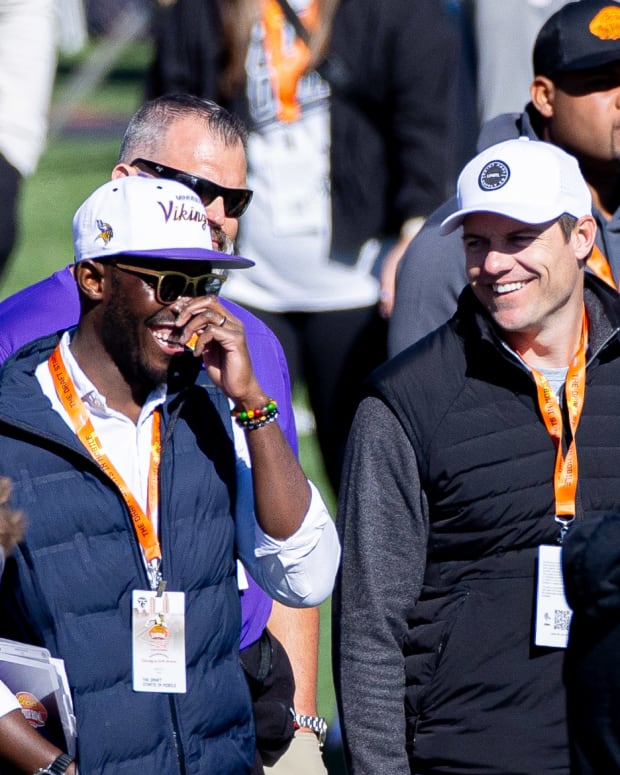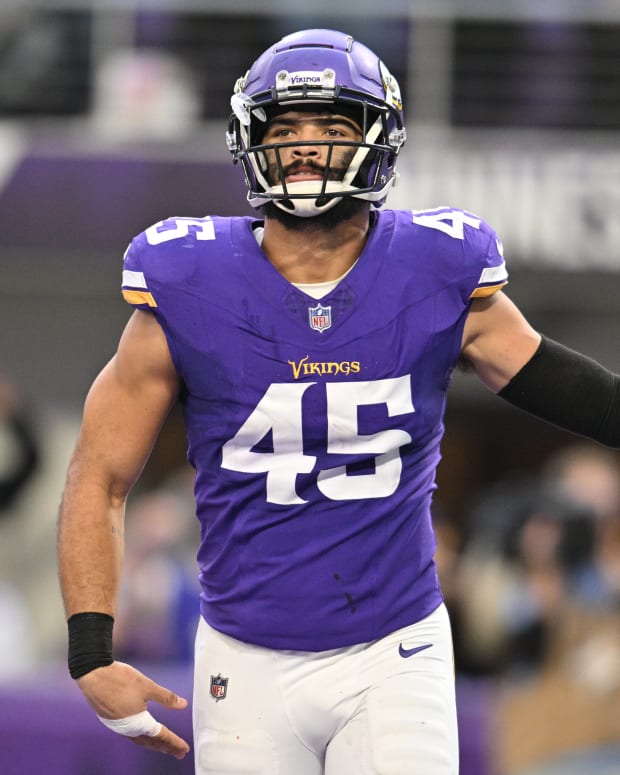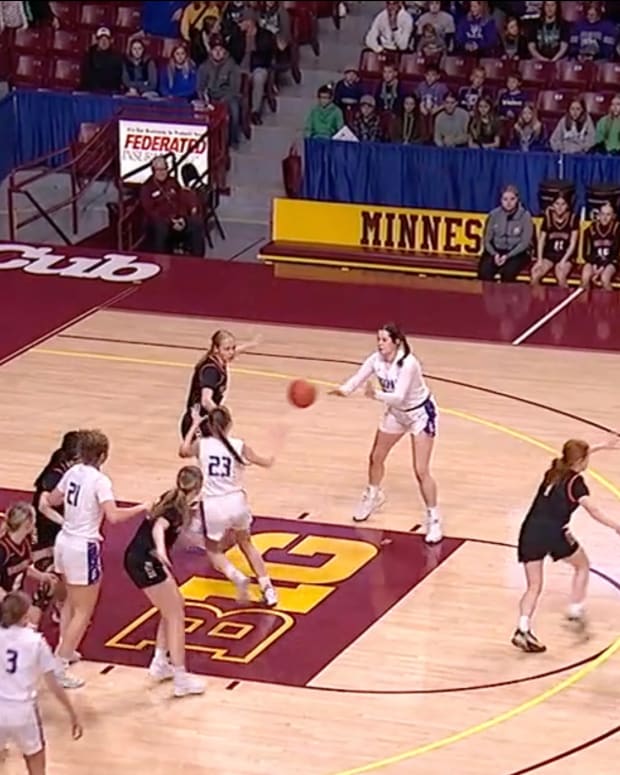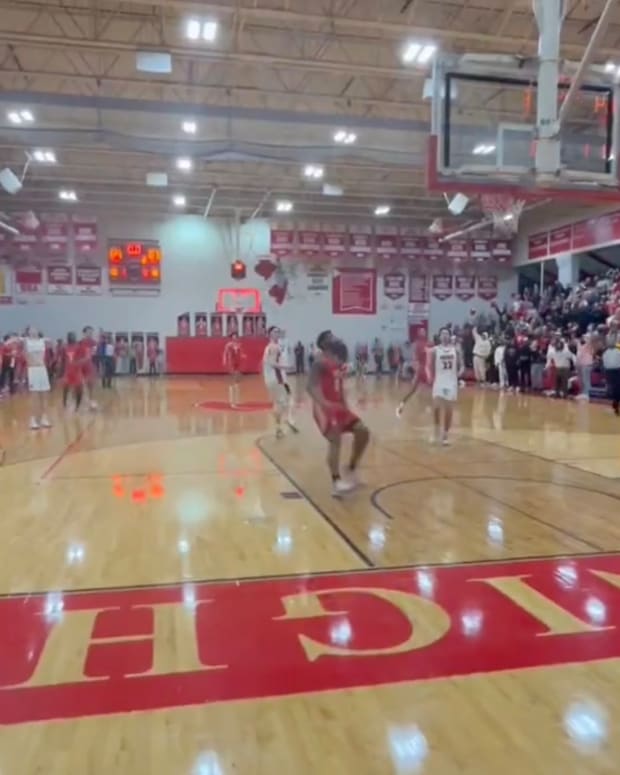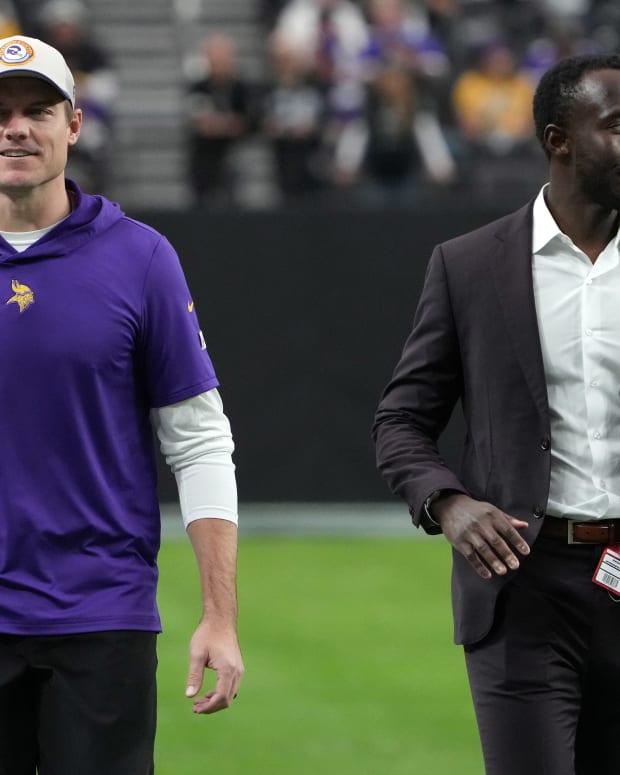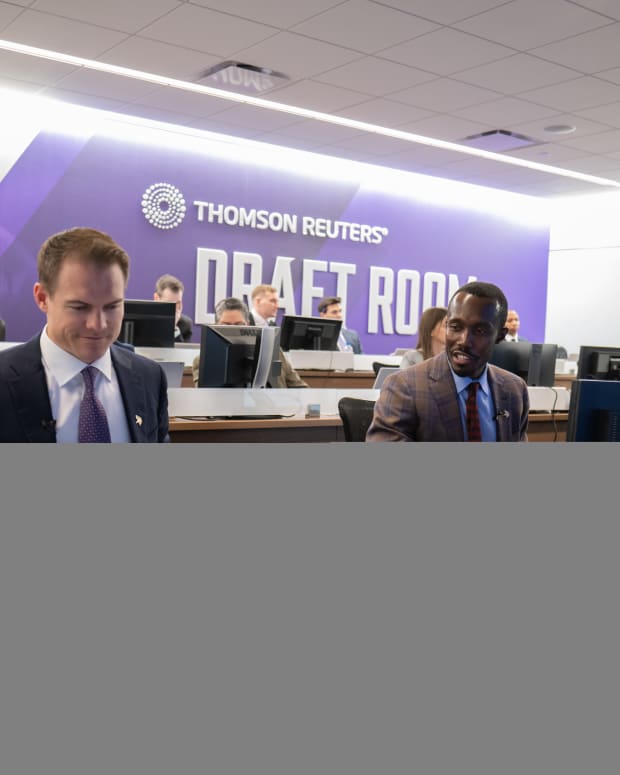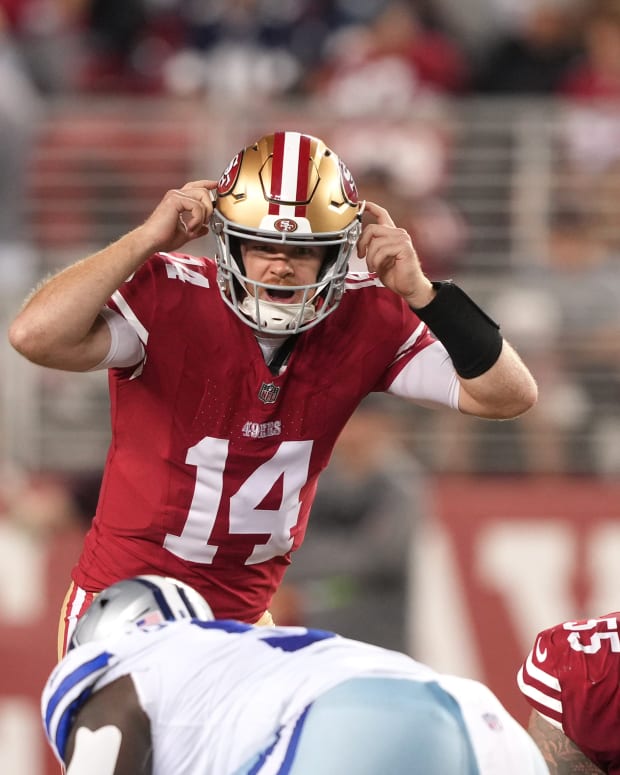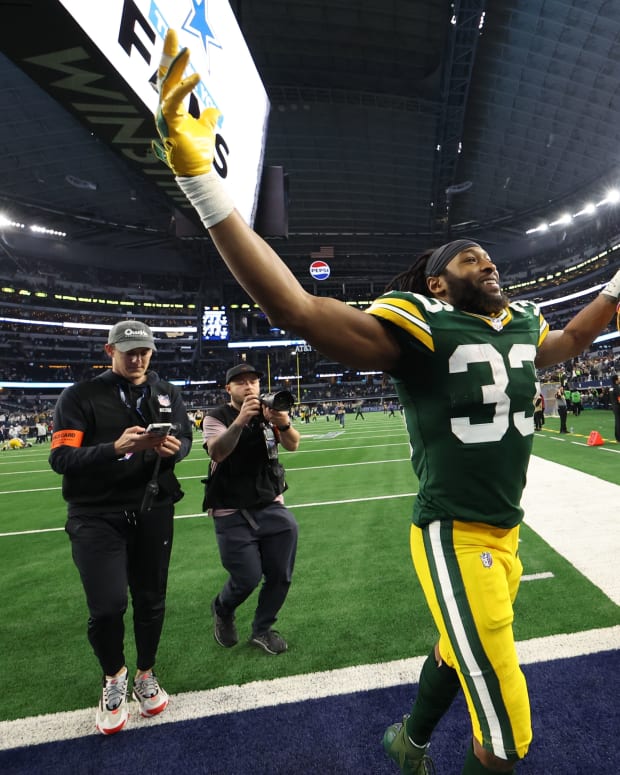The hidden value of TJ Hockenson's contract
In the aftermath of hiring Kwesi Adofo-Mensah as their general manager this offseason, much of the discourse surrounding the Vikings' organization was how the new regime could create small edges in the team-building process.
Most of those will take several years to cultivate and be fully actualized, but in the 10 months since Adofo-Mensah arrived in Minnesota, there have been seen glimpses of what that may look like – the frequent trading back in the NFL Draft is the most visible of them so far.
But the trade this week for tight end T.J. Hockenson presents a possible edge Adofo-Mensah may be trying to exploit.
That advantage lies in the salary cap. Hockenson is under contract for the remainder of this season along with the 2023 season as the Detroit Lions already picked up his fifth-year option. Hockenson’s base salary jumps up to $9.3 million next year.
From a short-term perspective, it is a value add for Minnesota. At $9.3 million next season, Hockenson has the 10th-highest cap hit among tight ends, while being a fringe top-5 player at the position (oh the joys of a rookie contract).
“[It was] certainly a component of it,” Adofo-Mensah said when asked whether Hockenson’s contract impacted the deal. “We’re always trying to solve this riddle that we have to try to build the best team we can with the constraints with the salary cap being one of them. We like the value of the contract and we also like the player.”
Among those with bigger cap hits are Jonnu Smith ($17.4 million), Hunter Henry ($15.5 million), Taysom Hill ($13.9 million), Zach Ertz ($12.8 million) and C.J. Uzomah ($10.3 million).
Projecting out, Hockenson will likely seek around $15-17 million AAV (average annual value) in his extension with Minnesota. Darren Waller is currently the highest-paid tight end. He signed a three-year, $51 million contract ($17 million AAV) in September. George Kittle is the second-highest, averaging $15 million per year. While Hockenson has not shown himself to be a top-two tight end in the league, the reality is he will get paid like it. That’s how the NFL works. Hockenson will get a top-of-market deal this year that will be eclipsed by whichever similarly talented tight end comes next.
But the value for Minnesota has the chance to remain even if it extends Hockenson and makes him one of the highest-paid tight ends in the league.
For this exercise, let’s imagine Hockenson signs the same deal as Kittle, a 5-year, $75 million contract, making him a top-three paid tight end. Again, that price feels steep when looking at the tight end landscape, but how does that compare to the wide receiver market?
Tyreek Hill is currently the highest-paid wide receiver with a $30 million cap hit in 2023. There are 20 wide receivers currently scheduled to make more than the highest-paid tight end – Waller at $17 million – next season.
This isn’t a new phenomenon. Wide receivers have consistently been paid more than tight ends, but as more and more tight ends seem to be tight-ends-in-name-only, foregoing most traditional blocking duties and instead being highly effective mismatches in the passing game, the market has not caught up. Travis Kelce, currently making just shy of $15 million a year, is paid roughly the same as Robbie Anderson.
Like other uber-athletic tight ends – Kittle, Waller, Kelce and Mark Andrews – Hockenson’s greatest asset is as a receiver. With Detroit this season, Hockenson was targeted 41 times, second-most on a team that’s currently fourth in the NFL in yards per game. Among all pass-catchers with at least 40 targets, Hockenson ranks 10th in yards per catch (15.6). He ranks first among tight ends in that stat.
He has lined up in the slot or out wide on 56 percent of his career snaps. That’s still considerably lower than tight ends like Andrews and Waller, who line up out wide or in the slot on about 80 percent of snaps. So Hockenson isn’t a tight-end-in-name-only, but Minnesota surely didn’t trade for his blocking abilities (He ranks 28th in pass blocking and 35th in run blocking out of 39 tight ends that have taken at least 50 percent of their teams' snaps) and has pass-blocked on just nine percent of his career snaps.
He is, at minimum, the No. 3 option in this Vikings offense and might even eclipse Adam Thielen as the go-to option after Justin Jefferson.
If Minnesota treats Hockenson as its de facto No. 2 receiver, his contract suddenly becomes comparable to the wide receiver market.
For $15 million per year, Hockenson would be the 25th highest-paid receiver, in line with Courtland Sutton and Adam Thielen. Just below that number are receivers like the aforementioned Robbie Anderson, Corey Davis, Curtis Samuel and Michael Gallup.
That’s where the edge comes in: paying an average of $15 million per year for the next four or five seasons is a bargain for a strong No. 2 wide receiver that’s only 25 years old. And, of course, he does much more than just catch passes. O’Connell explained how a quality all-around tight end can help tie together the run and pass game.
“If you block a run a certain way and you want to have a play pass off of that, nine times out of 10, the tight end has to have a real strong hand in blocking in the play pass as well with maybe a tougher matchup on the edges,” O’Connell said. “I think he’s proven that he can handle that workload as well as be a real factor in the pass game.”
Consider the downstream effect that has on Minnesota’s ability to build a roster, regardless of whichever path the Vikings choose.
If Minnesota moves forward with Kirk Cousins, that will once again come with a big cap number. The ability to save a few million dollars here and there becomes even more important as the team will need extra flexibility elsewhere. If the Vikings opt to go cheaper at quarterback, Hockenson’s cap number won’t be prohibitive from Minnesota going out and signing another expensive wide receiver to pair with him and Jefferson for a young quarterback to develop. Think what the Dolphins did for Tua Tagovailoa bringing in Hill or the Eagles trading for A.J. Brown.
With Jefferson lined up for a massive extension of his own, the less the Vikings need to spend on other weapons is beneficial.
Hockenson provides added flexibility for all of those scenarios.
The value added isn’t immense in this scenario, but had the Vikings chased a traditional No. 2 wide receiver instead, it likely would’ve cost them more draft capital and more financial resources in an extension.
Brandin Cooks was a trade candidate, but the next two years of his contract are worth $26 and $24 million. Even with a restructuring, he’s likely making more than what Hockenson will on his next contract. Jerry Jeudy was another option, but he would’ve likely garnered more in his next contract as well.
Would it have been warranted? There are arguments for adding each player based on the personnel they’d play with, but using 538’s recently published wide receiver rankings, which is based on ESPN’s analytical data, T.J. Hockenson has been the 37th-best receiver this season, regardless of position. Jeudy is ranked 61st. Cooks is ranked 94th.
Adofo-Mensah is betting on head coach Kevin O’Connell’s ability to scheme up T.J. Hockenson and Cousins to find him.
“Adding a player of T.J.’s caliber in a moment where we’re really kind of coming into our groove, I see a fit with a lot of the things we try to do – a lot of things route-wise, schematics, how we run the ball,” O’Connell said. “Situationally, I see some real opportunities for him – third down, red zone, 2-minute, things like that. It’s just a matter of bringing a player here that we feel has tremendous upside in our offense.”
Thus far this season, neither of those things has been true. Per ESPN’s Kevin Seifert, the Vikings’ tight ends are averaging 7.3 yards per reception this season, the lowest in the NFL. The tight end group ranks 26th in yards per game (38.6), and Cousins had a QBR of 38 when targeting tight ends which is 30th among quarterbacks this year.
“There’s some work to do,” Cousins said. “I asked our video guys yesterday, ‘Hey, can you put together a cut up of his career touchdowns, his career third-down conversions, his tape from Iowa that got him drafted in the top 10?’ I want to see these things, I want to see him at his absolute best, see what he’s done as a player, and that’ll help me better understand him when I’m with him in the game.”
The question is, was that an issue of talent? That's the bet Minnesota is making by bringing in Hockenson.
If the Vikings can unlock Hockenson within their offense, that’s a small edge that can help push a team that, for the first time in five years, has realistic aspirations of winning multiple playoff games.
Related: Matthew Coller: Vikings are all in with trade for TJ Hockenson
